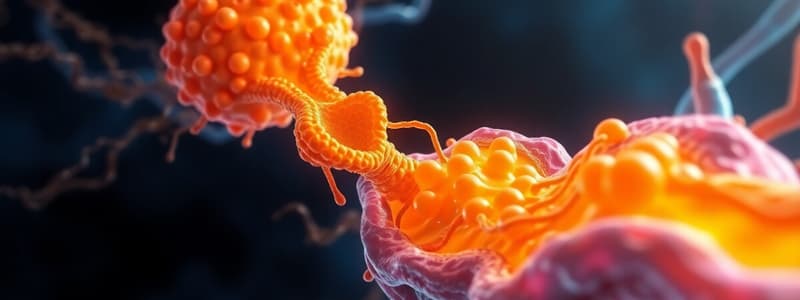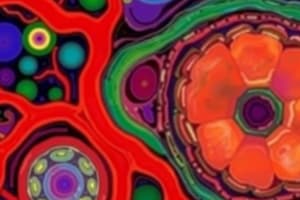Podcast
Questions and Answers
What is a primary function of the smooth endoplasmic reticulum?
What is a primary function of the smooth endoplasmic reticulum?
- Cellular respiration
- Ribosome storage
- Production of proteins
- Synthesis of lipids (correct)
What is the special name of the smooth ER found in muscle cells?
What is the special name of the smooth ER found in muscle cells?
- Cytosolic reticulum
- Chloroplast
- Sarcoplasmic reticulum (correct)
- Granular ER
Which of the following is NOT a function of the smooth endoplasmic reticulum?
Which of the following is NOT a function of the smooth endoplasmic reticulum?
- Detoxification of harmful substances
- Production of enzymes for liver metabolism
- Synthesis of steroid hormones
- Storage of ATP molecules (correct)
Where is the smooth endoplasmic reticulum primarily located within the cell?
Where is the smooth endoplasmic reticulum primarily located within the cell?
Which of the following statements about the smooth ER is true?
Which of the following statements about the smooth ER is true?
What is the primary function of heterophagia?
What is the primary function of heterophagia?
What are primary lysosomes primarily responsible for?
What are primary lysosomes primarily responsible for?
What characterizes secondary lysosomes?
What characterizes secondary lysosomes?
During autophagy, what happens to unnecessary or damaged cellular components?
During autophagy, what happens to unnecessary or damaged cellular components?
What is the final outcome for indigestible molecules in secondary lysosomes?
What is the final outcome for indigestible molecules in secondary lysosomes?
What is one key function of the endoplasmic reticulum?
What is one key function of the endoplasmic reticulum?
What distinguishes rough ER from smooth ER?
What distinguishes rough ER from smooth ER?
Which of the following correctly describes the structure of the endoplasmic reticulum?
Which of the following correctly describes the structure of the endoplasmic reticulum?
Which substance is stored by the endoplasmic reticulum?
Which substance is stored by the endoplasmic reticulum?
What happens in the lumen of rough ER?
What happens in the lumen of rough ER?
What process do lysosomes facilitate to remove damaged cellular components?
What process do lysosomes facilitate to remove damaged cellular components?
What role do lysosomes play in cellular repair?
What role do lysosomes play in cellular repair?
What occurs during the autolysis of a cell?
What occurs during the autolysis of a cell?
Which of the following materials are lysosomes capable of breaking down?
Which of the following materials are lysosomes capable of breaking down?
What is the primary function of the Golgi network?
What is the primary function of the Golgi network?
Which network of the Golgi is closest to the endoplasmic reticulum (ER)?
Which network of the Golgi is closest to the endoplasmic reticulum (ER)?
Which process describes the recycling of broken down molecules into new cellular products?
Which process describes the recycling of broken down molecules into new cellular products?
What is the primary function of lysosomes in a cell?
What is the primary function of lysosomes in a cell?
How are lysosomes formed within the cell?
How are lysosomes formed within the cell?
What occurs to proteins and lipids when they enter the Golgi?
What occurs to proteins and lipids when they enter the Golgi?
What is the internal pH of lysosomes, which is necessary for their function?
What is the internal pH of lysosomes, which is necessary for their function?
What type of vesicles leave the Golgi after processing?
What type of vesicles leave the Golgi after processing?
Which of the following is NOT produced by the Golgi network?
Which of the following is NOT produced by the Golgi network?
What type of enzymes do lysosomes contain to degrade molecules?
What type of enzymes do lysosomes contain to degrade molecules?
What process allows external materials to enter the cell and be delivered to lysosomes?
What process allows external materials to enter the cell and be delivered to lysosomes?
What is the primary role of protein trafficking in a cell?
What is the primary role of protein trafficking in a cell?
Which component of the Golgi apparatus is farthest from the endoplasmic reticulum?
Which component of the Golgi apparatus is farthest from the endoplasmic reticulum?
What does the endoplasmic reticulum - Golgi intermediate compartment (ERGIC) facilitate?
What does the endoplasmic reticulum - Golgi intermediate compartment (ERGIC) facilitate?
How are the cisternae in the Golgi apparatus structured?
How are the cisternae in the Golgi apparatus structured?
What are the three components of the Golgi apparatus named for?
What are the three components of the Golgi apparatus named for?
What is the role of ribosomes in a cell?
What is the role of ribosomes in a cell?
What happens during the elongation step of protein synthesis?
What happens during the elongation step of protein synthesis?
Where are ribosomes primarily made within a cell?
Where are ribosomes primarily made within a cell?
Which of the following best describes the structure of a ribosome during protein production?
Which of the following best describes the structure of a ribosome during protein production?
What occurs during the termination step of protein synthesis?
What occurs during the termination step of protein synthesis?
What happens to vesicles as they move through the Golgi apparatus?
What happens to vesicles as they move through the Golgi apparatus?
What is the role of the trans face of the Golgi apparatus?
What is the role of the trans face of the Golgi apparatus?
Which modification is NOT mentioned as occurring to proteins and lipids in the Golgi apparatus?
Which modification is NOT mentioned as occurring to proteins and lipids in the Golgi apparatus?
What structure in the Golgi apparatus is responsible for receiving incoming vesicles?
What structure in the Golgi apparatus is responsible for receiving incoming vesicles?
Which of the following is a final destination for molecules processed in the Golgi apparatus?
Which of the following is a final destination for molecules processed in the Golgi apparatus?
Flashcards are hidden until you start studying
Study Notes
Smooth ER
- Located near the cell periphery, the smooth endoplasmic reticulum (SER) lacks ribosomes, distinguishing it from rough ER.
- Functions include lipid, steroid, and carbohydrate synthesis, along with metabolizing drugs and toxins.
- The type of cell influences the specific functions of the SER.
- In muscle cells, it's known as the sarcoplasmic reticulum, regulating calcium ion concentrations during muscle contraction and relaxation.
- In adrenal glands, SER secretes cholesterol, a precursor to steroid hormones.
- In liver cells, SER synthesizes and stores detoxifying enzymes to process harmful substances like alcohol and drugs.
Functions of ER
- Rough ER (RER) is primarily responsible for protein production, while SER synthesizes phospholipids and steroids.
- The ER detoxifies harmful exogenous molecules and regulates calcium ion sequestration and release.
Lysosomes
- Heterophagia involves breaking down foreign substances absorbed via endocytosis.
- Autophagy is the process of degrading internal materials, including nutrients and dysfunctional organelles.
- Autolysis occurs when lysosomes rupture, digesting the cell due to pathology or aging.
- Primary lysosomes form from the Golgi apparatus and contain inactive hydrolases for degrading large molecules.
- Secondary lysosomes form when primary lysosomes merge with endocytic vesicles, digesting various materials and recycling products to the cytoplasm.
Endoplasmic Reticulum Structure and Function
- The endoplasmic reticulum (ER) produces, processes, and secretes proteins, playing a vital role in every cell of humans and other organisms.
- Its structure consists of interconnected flattened sheets (cisternae) and tubules, facilitating efficient function.
- Rough ER is studded with ribosomes, while the smooth ER lacks them.
Rough ER
- Lumen of rough ER is narrower than that of smooth ER.
- Central to protein synthesis as ribosomes translate mRNA into proteins, which are then modified and transported.
Golgi Network
- Composed of two networks: cis and trans Golgi networks, each made of multiple cisternae.
- The cis Golgi network is adjacent to the ER, while the trans Golgi network is the farthest.
- The Golgi modifies proteins and lipids received from the ER, packaging them into vesicles for transport.
Protein Trafficking
- Newly synthesized proteins are transported from the ER to the Golgi for modification and sorting to their destinations.
- The Golgi creates polysaccharides and packages proteins and lipids within vesicles for secretion or internal use.
Lysosome Functionality
- Lysosomes are membrane-bound organelles responsible for cellular waste degradation and recycling.
- Their acidic internal environment (pH 4.5-5.5) contains hydrolytic enzymes, facilitating the breakdown of internal and external materials.
- They play a role in autophagy, cellular repair, and can trigger autolysis when a cell is irreparably damaged.
Ribosome Structure and Function
- Ribosomes are essential for protein synthesis, directing what type of proteins are produced based on location.
- Composed of two subunits (large and small), they come together to facilitate protein production when needed.
- The ribosomal process involves initiation, elongation, and termination of protein synthesis.
Golgi Apparatus Structure
- The Golgi apparatus, made up of stacked pouches called cisternae, operates closely with the ER.
- Composed of the cis face (closest to the ER), trans face (farthest from the ER), and medial section, it processes proteins and lipids.
- The endoplasmic reticulum-Golgi intermediate compartment (ERGIC) facilitates transport between the ER and Golgi.
Golgi Processing Steps
- Proteins or lipids leave the ER as vesicles, enter the Golgi at the cis face, and are modified as they move through its lumen.
- Modifications may include sugar replacements or the addition of fatty acids or phosphates.
- At the trans face, molecules are sorted and packaged into vesicles for delivery to specific cellular locations.
Studying That Suits You
Use AI to generate personalized quizzes and flashcards to suit your learning preferences.




